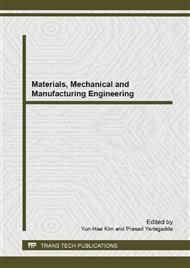[1]
J.W. Goodman, some fundamental properties of speckle, J. Opt. Soc. Amer., Vol. 66 (1976) , pp.145-1150.
Google Scholar
[2]
J.G. Abbott, F.L. Thurstone, Acoustic speckle: Theory and experimental analysis, Ultrasonic Imaging, Vol. 1 (1979), pp.303-324.
DOI: 10.1177/016173467900100402
Google Scholar
[3]
J.S. Lee, I. Jurkevich, P. Dewaele, P. Wambacq, A. Oosterlink, Speckle filtering of synthetic aperture radar images: a review, Remote Sensing Reviews, Vol. 8 (1994), pp.313-340.
DOI: 10.1080/02757259409532206
Google Scholar
[4]
V.S. Frost, J.A. Stiles, K.S. Shanmugan, J.C. Holtzman, A model for radar images and its application to adaptive digital filtering of multiplicative noise. IEEE Transaction of pattern Analysis and Machine Intelligence. Vol. 4 (1982), pp.157-166.
DOI: 10.1109/tpami.1982.4767223
Google Scholar
[5]
D.T. Kuan, A. A Sawchuk, T.C. Stand, P. Chavel, Adaptive noise smoothing filtering for image with signal-dependent noise, IEEE Transaction of Pattern Analysis and Machine Intelligence, Vol. 7 (1985), pp.165-177.
DOI: 10.1109/tpami.1985.4767641
Google Scholar
[6]
J.S. Lee, Digital image enhancement and noise filtering by use of local stastics, IEEE Transactions of Pattern Analysis and Machine Intelligence, Vol. 2 (1980), pp.165-168.
DOI: 10.1109/tpami.1980.4766994
Google Scholar
[7]
A. Achim, P. Tsakalides, A. Bezeranos, SAR image denoising Via Bayesian wavelet Shrinkage based on heavy-Tailed modeling, IEEE Transactions on Geoscience and Remote Sensing, Vol. 41(2003) . pp.1773-1784.
DOI: 10.1109/tgrs.2003.813488
Google Scholar
[8]
S. Solbo, T. Eltoft, Hommomorphic wavelet-based statistical despeckling of SAR images, IEEE Transactions on Geoscience and Remote Sensing, Vol. 42 (2004), pp.711-721.
DOI: 10.1109/tgrs.2003.821885
Google Scholar
[9]
M. Mastriani A.E. Giraldez, Kalman's shrinkage for wavelet-based despeckling of SAR images, International journal of intelligent technology, Vol. 3 (2006), pp.190-196.
Google Scholar
[10]
Shi-qi Huang, Dai-zhi Liu, Gui-qing Gao, Xi-jian Guo, A novel method for speckle noise reduction and ship target detection in SAR images. Vol . 42(2009), pp.1533-1542.
DOI: 10.1016/j.patcog.2009.01.013
Google Scholar
[11]
Maria Elena Buemi, Julio Jacobo, Marta Mejail, SAR image processing using adaptive stack filter. Pattern Recognition Letters, Vol. 31(2010), pp.307-314.
DOI: 10.1016/j.patrec.2009.02.008
Google Scholar
[12]
Pham T. Q, Vliet L. J, Separable filtering for fast video preprocessing, Proceeding of IEEE international Conference on Multimedia and Expo, (2005), pp.454-457.
DOI: 10.1109/icme.2005.1521458
Google Scholar


